Open Data as a Condition for Smart Application Development: Assessing Access to Hospitals in Croatian Cities
Abstract
:1. Introduction
2. Related Work: Assessing Open Data Ecosystems
2.1. Ecosystem Approach to Open Data
2.2. Available Open Data Assessment Frameworks
3. Methodology
3.1. Methodological Approach for the Design of a User-Driven Assessment Framework
3.2. A New User-Driven Assessment Framework for Open Data
- Supply side (supply of open data on web portals);
- Demand side by researcher/developer—through the perspective of open data user skills working with data (e.g., data analyst, data scientist);
- Demand side by end-user—through end-user capabilities (end-user of the application, e.g., citizen);
- Legal and privacy aspects;
- Impact side—through innovation perspective (e.g., company/innovator creating the innovative application).
- Supply side—completeness, timeliness, ease of physical and electronic access, machine processability, non-discrimination, use of commonly owned or open standards, licensing, permanence;
- Demand by researcher/developer (open data user skills)—timeliness from user side, format from user side, licensing from user side and feedback.
- Demand by end-user—development as web and mobile application, stated pricing policy, multilingualism, voice-enabled options, usefulness, user engagement, i.e., interaction with app developer, possibility to add data, possibility to confirm data;
- Legal aspect—practice and reuse of data, license for distribution, funding by government, promotion of digital service in society;
- Impact side—employment of data scientists, user engagement, relevance of app for the specific sector, number of downloads, partnership (private–government, private–academic, private–city government), membership of company in professional organizations, positive balance sheet of the company, company website, multilingualism of website.
4. Application of the New Assessment Framework
4.1. A New User-Driven Assessment Framework for Open Data
4.2. Data Portals
4.3. Assessment of Open Data
5. Discussion
6. Conclusions
Author Contributions
Funding
Institutional Review Board Statement
Informed Consent Statement
Data Availability Statement
Acknowledgments
Conflicts of Interest
Appendix A
| Open Data Portal of Zagreb | ZG Geoportal | Public City Transport—ZET | ||||
|---|---|---|---|---|---|---|
| HOSPITALS | Hospital layer: addresses, longitude and latitude (WGS84), contacts | Download available in XLS CSV | Health layer: Croatian Health Insurance Fund, Health Centers, Emergency, Pharmacies, Duty Pharmacies and Health Institutions | View only + WMS service | - | - |
| PUBLIC TRANSPORT | - | - | Transport layer: tram stations, bus stations, railway stations | View only + WMS service | Network of bus and tram lines, map of bus and tram stations | Download available in PDF format |
| BICYCLE PATH | Infrastructure layer: bicycle paths—length, coordinates of path midpoint | Download available in XLS CSV | Transport layer: bicycle paths and bicycle garages | View only + WMS service | - | - |
| TRAFFIC ROADS | - | - | Transport layer: roads | View only + WMS service | - | - |
| OTHER RELEVANT DATASETS | - | - | Public garages, pedestrian zones, taxi stands, gas stations | View only + WMS service | - | - |
| Grad Split Hub | Promet Split | |||
|---|---|---|---|---|
| HOSPITALS | Healthcare facilities: geolocation, address, type of facility, contact | View only on a map | - | - |
| PUBLIC TRANSPORT | - | - | Bus lines | Download available in PDF |
| BICYCLE PATH | Bicycle station: geolocation, type, number of lots, purpose | View only on a map | - | - |
| TRAFFIC ROADS | - | - | - | - |
| OTHER RELEVANT DATASETS | Garages and parking lots: geolocation, type, number of lots, purpose | View only on a map | - | - |
| GIS Browser City of Rijeka | National Open Data Portal | Rijeka Promet d.d. | BikeRijeka | ||||
|---|---|---|---|---|---|---|---|
| HOSPITALS | - | Health Insurance Institute—list of institutions | Download available in XLS and CSV | - | - | - | - |
| PUBLIC TRANSPORT | - | - | - | Bus lines and stations | Bus lines and stations | - | - |
| BICYCLE PATH | - | - | - | - | - | Paths on map | View on a downloadable mobile app |
| TRAFFIC ROADS | - | - | - | - | - | - | - |
| OTHER RELEVANT DATASETS | - | - | - | Parking lots, garages | Parking lots, garages | - | - |
References
- Rajabifard, A.; Feeney, M.-E.F.; Williamson, I.P.; Masser, I. National SDI Initiatives. In Developing Spatial Data Infrastructures: From Concept to Reality, 1st ed.; Williamson, I., Rajabifard, A., Feemey, M.-E.F., Eds.; CRC Press: London, UK, 2003; pp. 95–110. [Google Scholar]
- Masser, I. All shapes and sizes: The first generation of national spatial data infrastructure. Int. J. Geogr. Sci. 1999, 3, 67–84. [Google Scholar] [CrossRef]
- Vancauwenberghe, G.; Valeckaite, K.; van Loenen, B.; Welle Donker, F. Assessing the Openness of Spatial Data Infrastructures (SDI): Towards a Map of Open SDI. Int. J. Spat. Data Infrastruct. Res. 2018, 13, 88–100. [Google Scholar]
- Mensah, E.; Goderre, J.L. Data Sources and Data Tools: Preparing for the Open Data Ecosystem. In Public Health Informatics and Information Systems, 1st ed.; Magnuson, J.A., Dixon, B.E., Eds.; Springer: Cham, Switzerland, 2020; Volume 3, pp. 105–127. [Google Scholar]
- Van Knippenberg, L. Open Data Maturity. Report 2020; Publications Office of the European Union: Luxembourg, 2020; pp. 11–85. [Google Scholar]
- Capgemini Consulting, Data.europa.eu. Open Data Maturity in Europe 2021. Available online: https://www.capgemini.com/insights/research-library/open-data-maturity-report-2021/ (accessed on 17 August 2022).
- European Council. Digital Services Package. Available online: https://www.consilium.europa.eu/en/policies/digital-services-package/ (accessed on 3 March 2022).
- Seljan, S.; Miloloža, I.; Pejic Bach, M. e-Government in European Countries: Gender and Ageing Digital Divide. In Proceedings of the Interdisciplinary Management Research Conference XVI, Opatija, Croatia, 7–9 May 2020. [Google Scholar]
- Pejić Bach, M.; Seljan, S.; Zoroja, J.; Buljan, A.; Cafuta, B. Hospital websites as a road to transparency: Case study of transition countries. In Proceedings of the International Conference Knowledge and Business Challenge of Globalization in 2017, Celje, Slovenia, 17 November 2017. [Google Scholar]
- Pejić Bach, M.; Seljan, S.; Jaković, B.; Buljan, A.; Zoroja, J. Hospital Websites: From the Information Repository to Interactive Channel. Procedia Comput. Sci. 2019, 164, 64–71. [Google Scholar] [CrossRef]
- Seljan, S.; Baretić, M.; Seljan, M.; Pejić Bach, M. Information assessment of hospital websites in Croatia: How to develop accountability standards? Int. J. Health Plan. Manag. 2020, 35, 970–971. [Google Scholar] [CrossRef]
- Welle Donker, F.; van Loenen, B. How to assess the success of the open data ecosystem? Int. J. Digit. Earth New J. New Vis. 2017, 10, 284–306. [Google Scholar] [CrossRef]
- Dodds, L.; Newman, A. A Guide to the Open Data Maturity Model. Assessing Your Open Data Publishing and Use. Open Data Institute. Available online: https://theodi.org/article/open-data-maturity-model-2/ (accessed on 3 March 2022).
- IRM (Independent Reporting Mechanism). Aligning Supply and Demand for Better Governance: Open Data in the Open Government Partnership. Available online: https://www.opengovpartnership.org/stories/aligning-supply-and-demand-for-better-governance-open-data-in-the-open-government-partnership/ (accessed on 9 March 2022).
- World Wide Web Foundation. Open Data Barometer Global Report. 2nd Ed. Available online: https://opendatabarometer.org/2ndEdition/ (accessed on 9 March 2022).
- Open Knowledge International. “Global Open Data Index”. Available online: https://index.okfn.org/ (accessed on 9 March 2022).
- Harrison, T.M.; Pardo, T.A.; Cook, M. Creating Open Government Ecosystems: A Research and Development Agenda. Future Internet 2012, 4, 900–928. [Google Scholar] [CrossRef]
- Zuiderwijk, A.; Janssen, M.; Davis, C. Innovation with open data: Essential elements of open data ecosystems. Inf. Polity 2014, 19, 17–33. [Google Scholar] [CrossRef]
- Davies, T. Open Data: Infrastructures and ecosystems. Open Data Res. 2001, 1–6. [Google Scholar]
- Rajabifard, A.; Mansourian, A.; Williamson, I.P.; Valadan Zoej, M.J. Developing Spatial Data Infrastructure to Facilitate Disaster Management. In Proceedings of the Geomatics’83 Conference, Teheran, Iran, 9–12 May 2004. [Google Scholar]
- Jaeger, P.; Bertot, J. Transparency and Technological Change: Ensuring Equal and Sustained Public Access to Government Information. Gov. Inf. Q. 2010, 27, 371–376. [Google Scholar] [CrossRef]
- Lee, D.; Derilinx. Discovering Open Data Standards. Available online: https://www.w3.org/2016/11/sdsvoc/SDSVoc16_paper_29 (accessed on 9 March 2022).
- Van Loenen, B.; Vancauwenberghe, G.; Crompvoets, J.; Dalla Corte, L. Open Data Exposed. In Information Technology and Law Series; Van Loenen, B., Vancauwenberghe, G., Crompvoets, J., Eds.; Springer: Berlin/Heidelberg, Germany, 2018; Volume 30, pp. 1–30. [Google Scholar]
- Poikola, A.; Kola, P.; Hintikka, K.A. Public Data an Introduction to Opening Information Resources. Handbook by Ministry of Transport and Communications, Helsinki. 2010. Available online: https://julkaisut.valtioneuvosto.fi/bitstream/handle/10024/78201/Public_data_-_an_introduction_to_opening_information_resources.pdf?sequence=1 (accessed on 9 March 2022).
- Martin, S.; Turki, S.; Renault, S. Open Data Ecosystems. In Electronic Government and the Information Systems Perspective; Kő, A., Francesconi, E., Eds.; Springer: Cham, Switzerland, 2015; Volume 10441, pp. 49–63. [Google Scholar]
- Frontier Economics. Increasing Access to Data across the Economy. A Report Prepared for the Department for Digital, Culture, Media and Sport. Available online: https://assets.publishing.service.gov.uk/government/uploads/system/uploads/attachment_data/file/974532/Frontier-access_to_data_report-26-03-2021.pdf (accessed on 9 March 2022).
- Zheng, L.; Kwok, W.M.; Aquaro, V.; Qi, X.; Lyu, W. Evaluating global open government data: Methods and status. In Proceedings of the 13th International Conference on Theory and Practice of Electronic Governance, Tokyo, Japan, 23–25 September 2020. [Google Scholar]
- Kamariotou, M.; Kitsios, F. Bringing Digital Innovation Strategies and Entrepreneurship: The Business Model Canvas in Open Data Ecosystem and Startups. Future Internet 2022, 14, 127. [Google Scholar] [CrossRef]
- Alexopoulos, C.; Loukis, E.; Mouzakitis, S.; Petychakis, M.; Charalabidis, Y. Analysing the Characteristics of Open Government Data Sources in Greece. J. Knowl. Econ. 2018, 9, 721–753. [Google Scholar] [CrossRef]
- Žuffova, M. Governing by Rankings: How the Global Open Data Index Helps Advance the Open Data Agenda. Available online: https://papers.ssrn.com/sol3/papers.cfm?abstract_id=3081521 (accessed on 3 March 2022).
- Hollanders, H.; Es-Sadki, N. European Innovation Scoreboard 2021; Publications Office of the European Union: Luxembourg, 2021. [Google Scholar]
- Attard, J.; Orlandi, F.; Scerri, S.; Auer, S. A systematic review of open government data initiatives. Gov. Inf. Q. 2015, 32, 399–418. [Google Scholar] [CrossRef]
- Van Ooijen, C.; da Silva Carvalho, N.; Iordache, A.; Osimo, D. Measuring Data Demand within the Public Sector; The Lisbon Council as Part of Data.europe.eu; Publications Office of the European Union: Luxembourg, 2022; Available online: https://data.europa.eu/sites/default/files/report/Discussion_Paper_Measuring_Data_Demand_Within_the_Public_Sector.pdf (accessed on 3 May 2022).
- Zagreb Open Data Portal. Available online: http://data.zagreb.hr/ (accessed on 6 March 2022).
- Geoportal of Zagreb (Zagreb Spatial Data Infrastructure). Available online: https://geoportal.zagreb.hr/ (accessed on 6 March 2022).
- Zagreb Electric Tram. Public Transport of City of Zagreb. Available online: https://www.zet.hr/en (accessed on 6 March 2022).
- Grad Split Hub. Available online: https://hub-gradsplit.hub.arcgis.com/ (accessed on 6 March 2022).
- Promet Split. Public Transport of City of Split. Available online: https://www.promet-split.hr/ (accessed on 6 March 2022).
- Open Data Portal of City Rijeka. Available online: http://data.rijeka.hr/ (accessed on 6 March 2022).
- Rijeka Promet. Public Transport of City of Rijeka. Available online: https://www.autotrolej.hr/en/ (accessed on 6 March 2022).
- BikeRijeka. Bike Paths of Rijeka and Surrounding. Available online: https://bikerijeka.com/ (accessed on 6 March 2022).
- Central Bureau of Statistics of the Republic of Croatia 2021 Census. Available online: https://popis2021.hr/ (accessed on 6 March 2022).
- Croatian Health Insurance Fund. Available online: https://hzzo.hr/en (accessed on 6 March 2022).
- Open Data Portal of Republic of Croatia. Available online: https://data.gov.hr/ckan/organization/hrvatski-zavod-za-zdravstveno-osiguranje (accessed on 6 March 2022).
- Apicella, L.; De Martino, M.; Quarati, A. Copernicus User Uptake: From Data to Applications. ISPRS Int. J. Geo-Inf. 2022, 11, 121. [Google Scholar] [CrossRef]
- Shirinyan, E.; Petrova-Antonova, D. Modeling Buildings in CityGML LOD1: Building Parts, Terrain Intersection Curve, and Address Features. ISPRS Int. J. Geo-Inf. 2022, 11, 166. [Google Scholar] [CrossRef]
- Gencarelli, C.N.; Voltolina, D.; Hammouti, M.; Zazzeri, M.; Sterlacchini, S. Geospatial Information Technologies for Mobile Collaborative Geological Mapping: The Italian CARG Project Case Study. ISPRS Int. J. Geo-Inf. 2022, 11, 192. [Google Scholar] [CrossRef]
- Herold, H.; Behnisch, M.; Hecht, R.; Leyk, S. Geospatial Modeling Approaches to Historical Settlement and Landscape Analysis. ISPRS Int. J. Geo-Inf. 2022, 11, 75. [Google Scholar] [CrossRef]
- Jażdżewska, I.A.; Lechowski, Ł.; Babuca, D. GIS-Based Approach for the Analysis of Geographical Education Paths. ISPRS Int. J. Geo-Inf. 2022, 11, 41. [Google Scholar] [CrossRef]
- Kocaman, S.; Saran, S.; Durmaz, M.; Kumar, S. Editorial on the Citizen Science and Geospatial Capacity Building. ISPRS Int. J. Geo-Inf. 2021, 10, 741. [Google Scholar] [CrossRef]
- Ibrahim, S.; Landa, M.; Pešek, O.; Brodský, L.; Halounová, L. Machine Learning-Based Approach Using Open Data to Estimate PM2.5 over Europe. Remote Sens. 2022, 14, 3392. [Google Scholar] [CrossRef]
- Reche, C.; Tobias, A.; Viana, M. Vehicular Traffic in Urban Areas: Health Burden and Influence of Sustainable Urban Planning and Mobility. Atmosphere 2022, 13, 598. [Google Scholar] [CrossRef]
- Hsu, Y.-Y.; Hawken, S.; Sepasgozar, S.; Lin, Z.-H. Beyond the Backyard: GIS Analysis of Public Green Space Accessibility in Australian Metropolitan Areas. Sustainability 2022, 14, 4694. [Google Scholar] [CrossRef]
- Takiya, H.; Negreiros, I.; Yamamura, C.L.K.; Quintanilha, J.A.; Machado, C.A.S.; Abiko, A.; Campos, C.I.d.; Pessoa, M.S.d.P.; Berssaneti, F.T. Application of Open Government Data to Sustainable City Indicators: A Megacity Case Study. Sustainability 2022, 14, 8802. [Google Scholar] [CrossRef]
- Zhang, W.; Jiang, H.; Shao, Q.; Shao, T. Construction of the Evaluation Model of Open Government Data Platform: From the Perspective of Citizens’ Sustainable Use. Sustainability 2022, 14, 1415. [Google Scholar] [CrossRef]
- Máchová, R.; Lněnička, M. Evaluating the Quality of Open Data Portals on the National Level. J. Theor. Appl. Electron. Commer. Res. 2017, 12, 21–41. [Google Scholar] [CrossRef]
- Rodosthenous, C.; Michail, D. Enabling Publishing and Reuse of Government Data Through the Republic of Cyprus Open Data Portal. In MTSR 2021: Metadata and Semantic Research; Communications in Computer and Information Science; Garoufallou, E., Ovalle-Perandones, M.A., Vlachidis, A., Eds.; Springer: Cham, Switzerland, 2022; Volume 1537. [Google Scholar] [CrossRef]
- Grzenda, M.; Legierski, J. Towards Increased Understanding of Open Data Use for Software Development. Inf. Syst. Front. 2021, 23, 495–513. [Google Scholar] [CrossRef]
- Tzitzikas, Y.; Pitikakis, M.; Giakoumis, G.; Varouha, K.; Karkanaki, E. How Can a University Take Its First Steps in Open Data? In MTSR 2020: Metadata and Semantic Research; Communications in Computer and Information Science; Garoufallou, E., Ovalle-Perandones, M.A., Eds.; Springer: Cham, Switzerland, 2021; Volume 1355. [Google Scholar] [CrossRef]
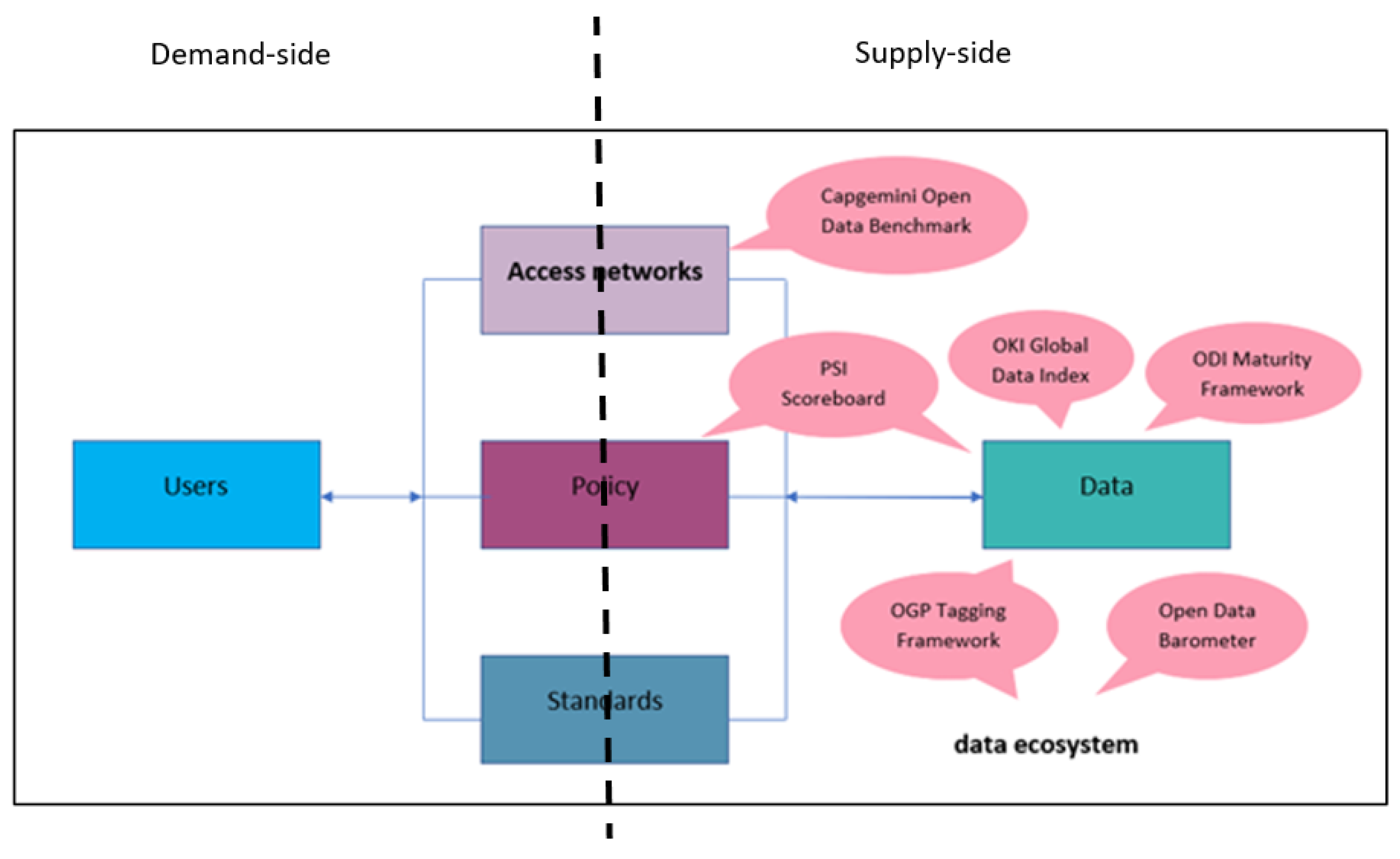
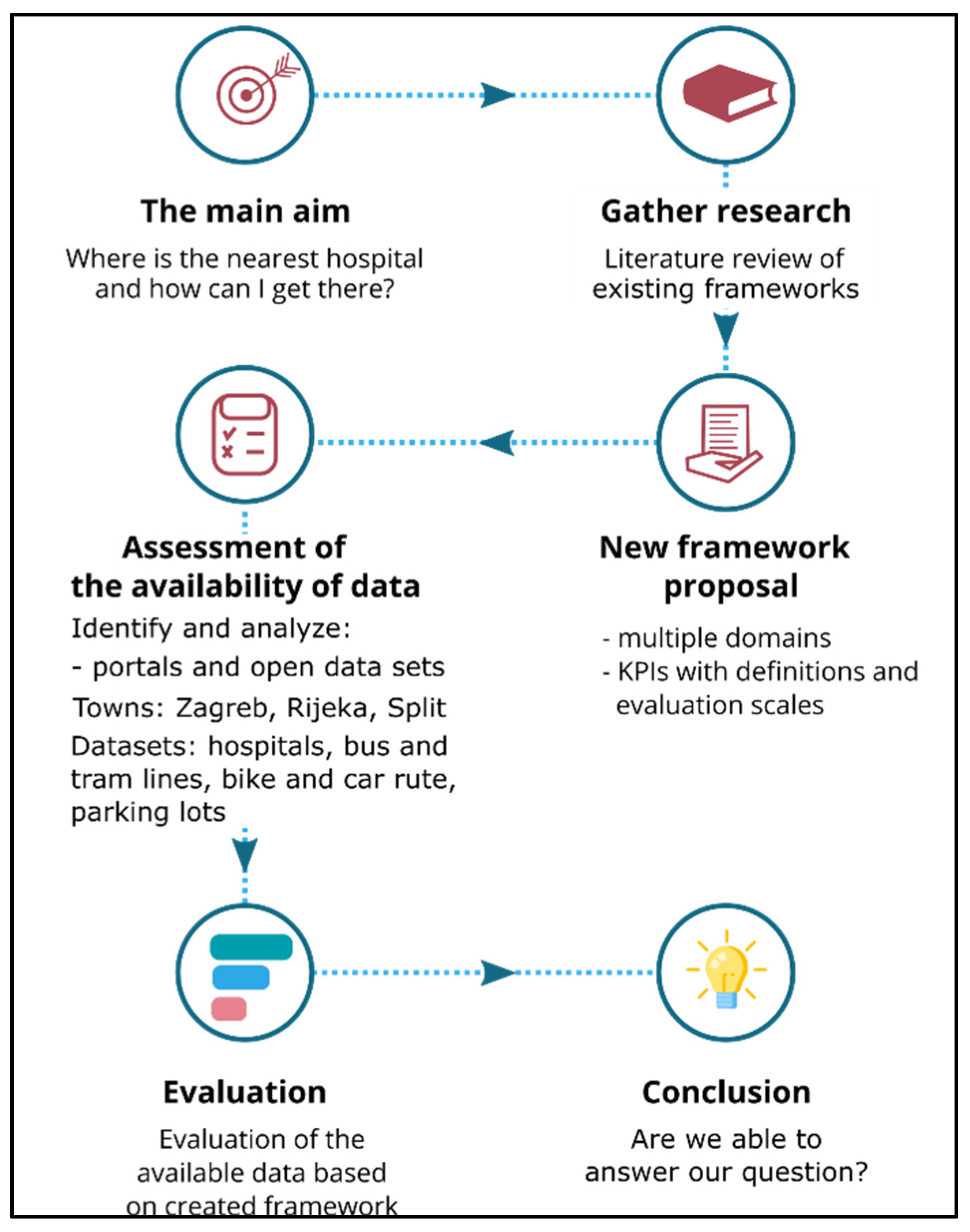
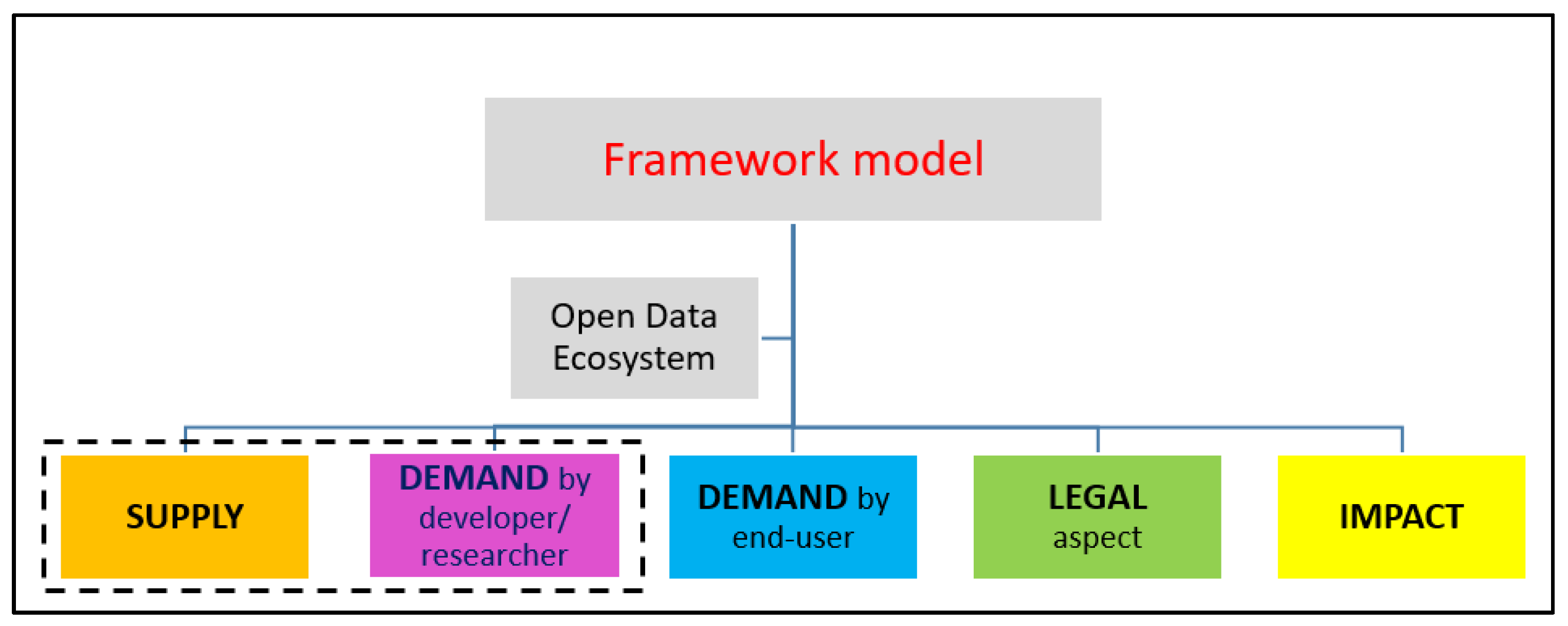

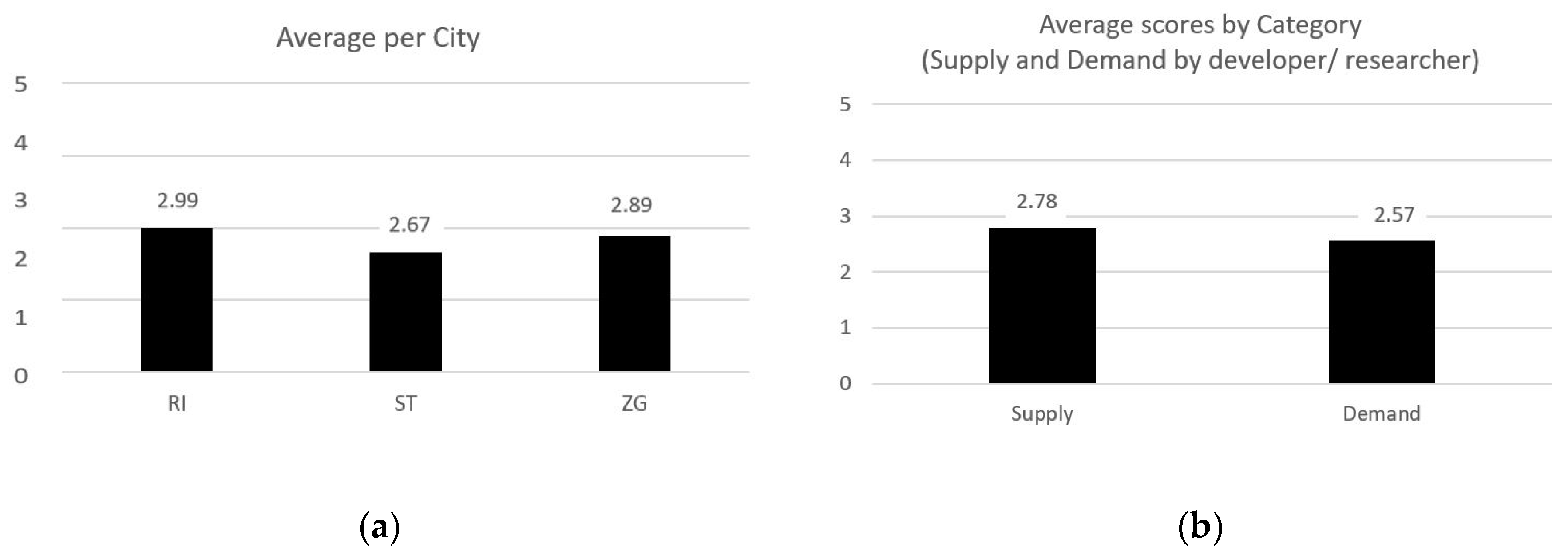
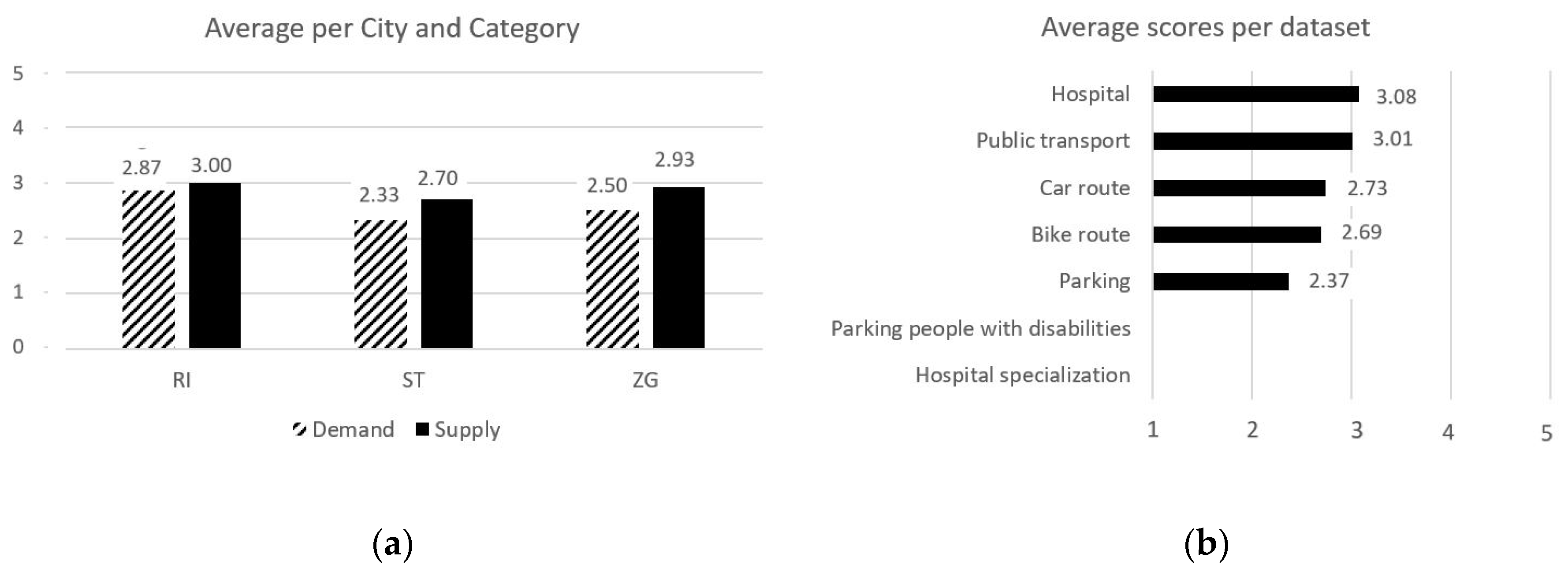

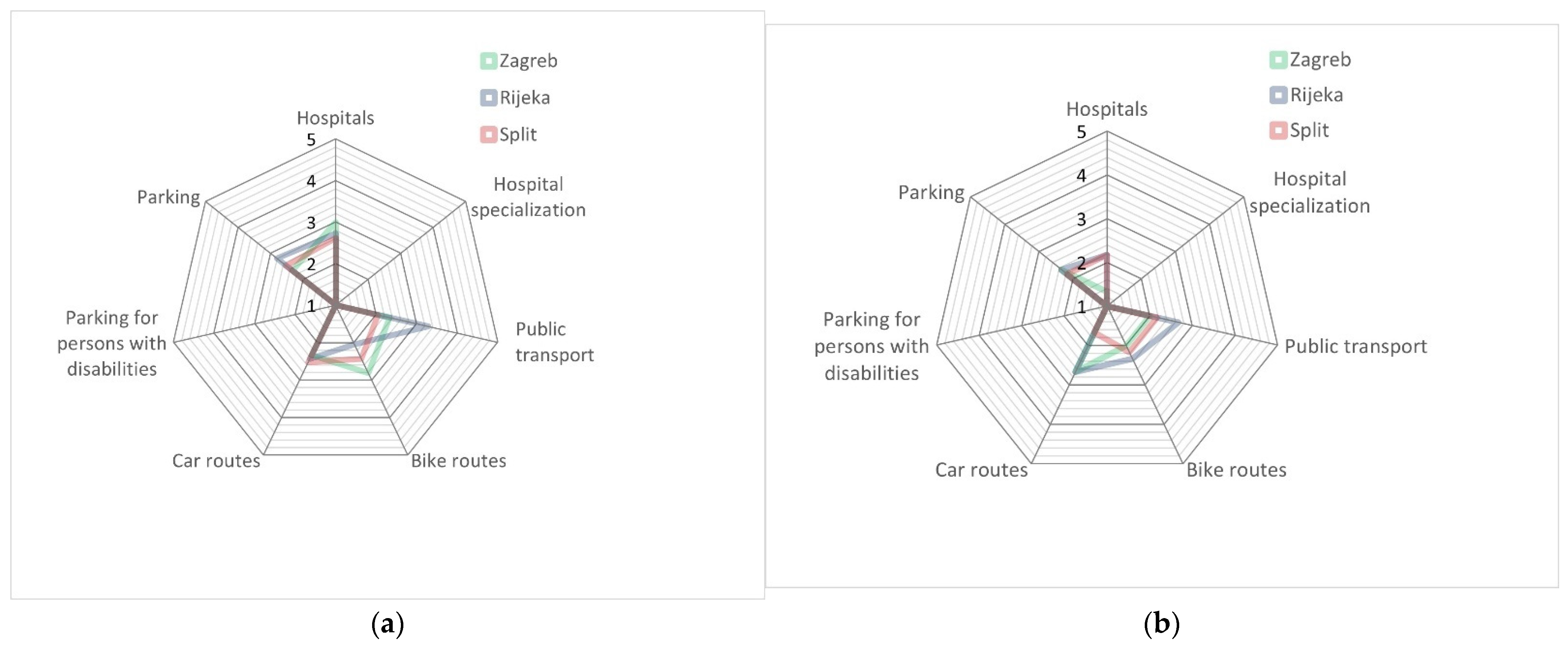

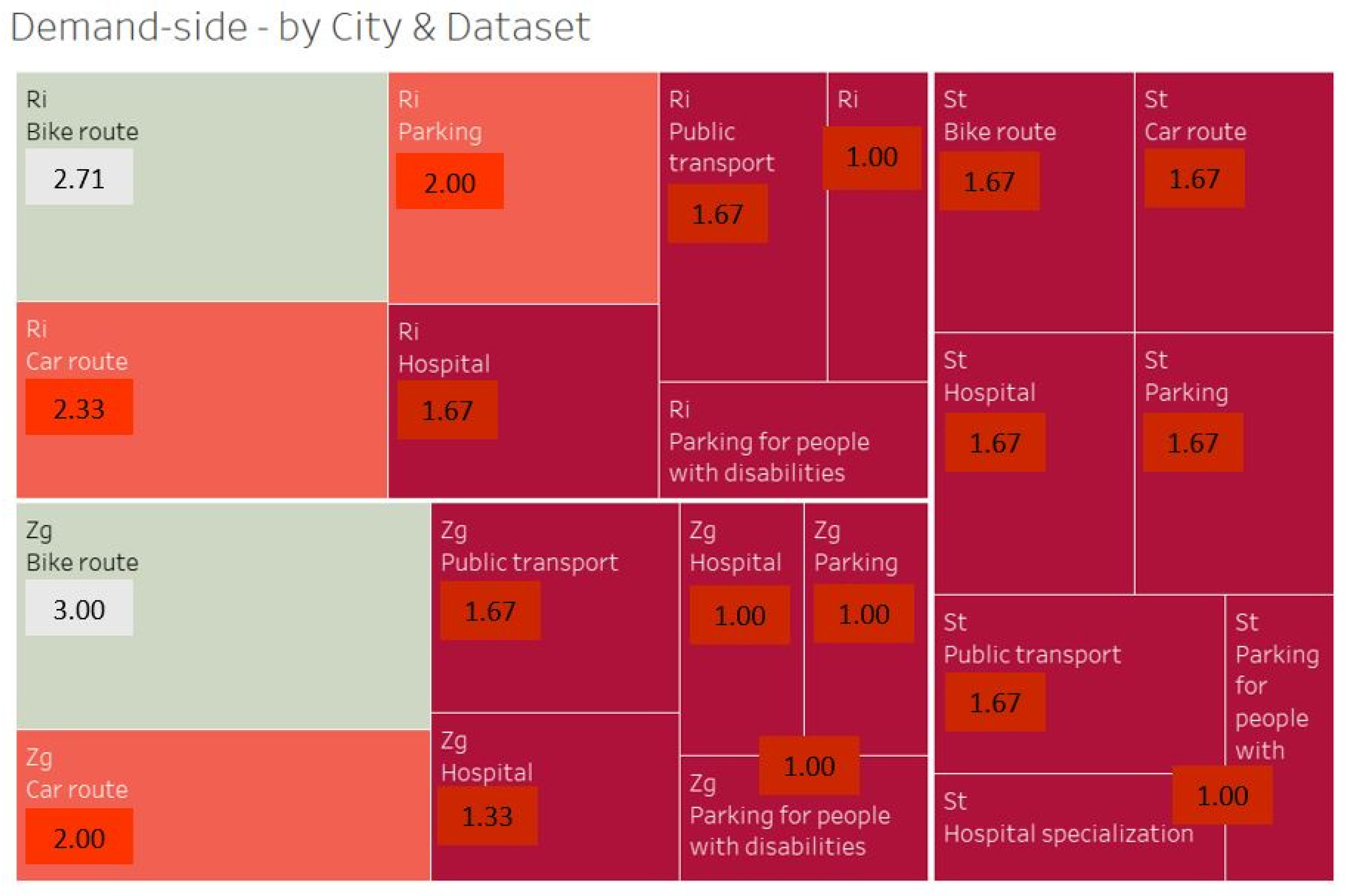
| Domains | Key Performance Indicators (KPIs) | Description | Scale |
|---|---|---|---|
| Supply side of evaluation Open data cross-domain quality | Completeness | Can the data be found? | 1—No, 5—Yes |
| Are these data available online in a data portal? | 1—No, 5—Yes | ||
| Are these data complete for our purpose? | 1—No, 3—Partially, 5—Yes | ||
| Do datasets have metadata in line with the commonly accepted standards? (OGC, DCAT, etc.) | 1—No, 3—Partially, 5—Yes | ||
| Are the metadata complete (at least mandatory fields are provided)? | 1—No, 3—Partially, 5—Yes | ||
| Identifiable details on how the data were collected? | 1—No, 3—Unknown, 5—Yes | ||
| Timeliness | Are the data up to date? | 1—No, 3—Partially (dynamic data are lagging), 5—Yes | |
| Ease of Physical and Electronic Access | Is it possible to access the data in electronic form (e.g., on the web)? | 1—No, 5—Yes | |
| Can data be filtered and downloaded through API—application programming interface? | 1—No, 3—Partially, 5—Yes.Answer yes if it is possible to access individual records; answer partially if it is possible to export only extracts of the particular data; answer no if there are only bulk downloads or APIs providing access to the whole dataset | ||
| Can data be fully downloaded through API? | 1—No, 3—Partially, 5—Yes.Answer no if it is only possible to access individual records; answer partially if it is possible to export extracts of the data; answer yes if there are bulk downloads or APIs providing access to the whole dataset | ||
| There are accessible and open official tools available to help users locate and explore individual records. | 1—No, 3—Partially, 5—Yes.Answer ‘partially’ if tools make it possible to access extracts of data without having to download a full dataset. Answer ‘yes’ if there is an interactive tool that displays user-filtered extracts of the data to answer simple questions without downloading data at all. | ||
| Machine processability | Data are provided in open machine-processable format(s). | 1—No, 3—Partially, 5—Yes.Type of machine-processable format(s): XML, RSS feed, CSV, RDF, JSON, TXT, XLS(S), KML | |
| Non-discrimination | Is registration or membership required for accessing the data? | 1—Yes (a registration is required only for member users), 2—Yes (no memberships are required), 3—Yes (one can register with any credentials), 5—No | |
| Is the dataset available free of charge? | 1—No, 5—Yes | ||
| Are data multilingual? | 1—No (only native), 3—Native and 1 more lang. 5—3 or more languages | ||
| Is there an option for voice guidance? | 1—No, 5—Yes | ||
| Are data provided in multiple appropriate formats? | 1—No, 5—Yes | ||
| Use of Commonly Owned or Open Standards | Are the data available in a format that supports visualization? | 1—No, 5—Yes | |
| Licensing | Is the dataset licensed with an open license? | 1—No, 5—Yes | |
| Permanence | Are data available online via the national open data catalogue service open.data.gov? | 1—No, 5—Yes | |
| Are data available online in other data portals? | 1—No, 5—Yes | ||
| Demand side of evaluation Developer/ researcher | Timeliness | Are the data up to date according to our purpose? | 1—No, 3—Partially (update frequency does not fit our purpose), 5—Yes |
| Machine processability | Data provided in a machine-processable format(s) fit for our purpose. | 1—No, 3—Partially (yes, but not fitting our purpose), 5—Yes | |
| Licensing | Does the license allow for usage fitting our purpose? | 1—No, there is no license available, 3—Some limitations, 5—Yes | |
| Feedback | What are feedback options for developers to communicate with the provider? | 1— No opportunities, 2—Contact information exists (email, telephone number) exists 3—Yes, we receive a generic email, 4—Yes, asynchronous communication (forum exists), 5—Yes, synchronous interactive communication | |
| Ease of Physical and Electronic Access | Can data be filtered and downloaded through API—application programming interface? | 1—No, 3—Partially, 5—Yes.Answer yes if it is possible to access individual records; answer partially if it is possible to export only extracts of the particular data; answer no if there are only bulk downloads or APIs providing access to the whole dataset | |
| Can data be fully downloaded through API? | 1—No, 3—Partially, 5—Yes.Answer no if it is only possible to access individual records; answer partially if it is possible to export extracts of the data; answer yes if there are bulk downloads or APIs providing access to the whole dataset |
| City | Zagreb | Split | Rijeka |
|---|---|---|---|
| Population 1 (City) | 777,183 | 151,790 | 109,775 |
| Urban 1 agglomeration | 1,086,528 | 325,407 | 188,797 |
| Hospitals 2 | Total: 217 Primary level: 190 Secondary level: 13 Tertiary level: 14 | Total: 25 Primary level: 20 Secondary level: 3 Tertiary level: 2 | Total: 7 Primary level: 3 Secondary level:3 Tertiary level: 1 |
| Public Transport | Railway: 29 lines Tram: 17 lines for day and 4 lines for night Bus: 177 day lines and 4 night bus lines | Railway: one line Bus: 20 day and 3 night city lines, and 30 intercity bus lines | Bus: 19 city lines and 33 intercity bus lines |
| Data portals | Zagreb Open Data Portal [34] ZG Geoportal [35] Zagrebački električni tramvaj [36] | Split Spatial Data Portal [37] Promet d. o.o. Split [38] | Rijeka Open Data Portal [39] Rijeka Promet d.d. [40] BikeRijeka Portal [41] |
| Type of Data/City | Hospitals | Public Transport | Bicycle Paths | Roads | ||||
|---|---|---|---|---|---|---|---|---|
| Available for Reuse | Comment | Available for Reuse | Comment | Available for Reuse | Comment | Available for Reuse | Comment | |
| ZAGREB | Yes | XLS/CSV | Yes | PDF format | Yes | XLS/CSV | Yes | WMS |
| SPLIT | Yes | View only on the map | Yes | PDF format | No | Only OSM | No | Only OSM |
| RIJEKA | No | Only on National Portal | Yes | PDF format | Yes | View only on the map | No | Only OSM |
Publisher’s Note: MDPI stays neutral with regard to jurisdictional claims in published maps and institutional affiliations. |
© 2022 by the authors. Licensee MDPI, Basel, Switzerland. This article is an open access article distributed under the terms and conditions of the Creative Commons Attribution (CC BY) license (https://creativecommons.org/licenses/by/4.0/).
Share and Cite
Seljan, S.; Viličić, M.; Nevistić, Z.; Dedić, L.; Grubišić, M.; Cibilić, I.; Kević, K.; van Loenen, B.; Welle Donker, F.; Alexopoulos, C. Open Data as a Condition for Smart Application Development: Assessing Access to Hospitals in Croatian Cities. Sustainability 2022, 14, 12014. https://doi.org/10.3390/su141912014
Seljan S, Viličić M, Nevistić Z, Dedić L, Grubišić M, Cibilić I, Kević K, van Loenen B, Welle Donker F, Alexopoulos C. Open Data as a Condition for Smart Application Development: Assessing Access to Hospitals in Croatian Cities. Sustainability. 2022; 14(19):12014. https://doi.org/10.3390/su141912014
Chicago/Turabian StyleSeljan, Sanja, Marina Viličić, Zvonimir Nevistić, Luka Dedić, Marina Grubišić, Iva Cibilić, Karlo Kević, Bastiaan van Loenen, Frederika Welle Donker, and Charalampos Alexopoulos. 2022. "Open Data as a Condition for Smart Application Development: Assessing Access to Hospitals in Croatian Cities" Sustainability 14, no. 19: 12014. https://doi.org/10.3390/su141912014
APA StyleSeljan, S., Viličić, M., Nevistić, Z., Dedić, L., Grubišić, M., Cibilić, I., Kević, K., van Loenen, B., Welle Donker, F., & Alexopoulos, C. (2022). Open Data as a Condition for Smart Application Development: Assessing Access to Hospitals in Croatian Cities. Sustainability, 14(19), 12014. https://doi.org/10.3390/su141912014






